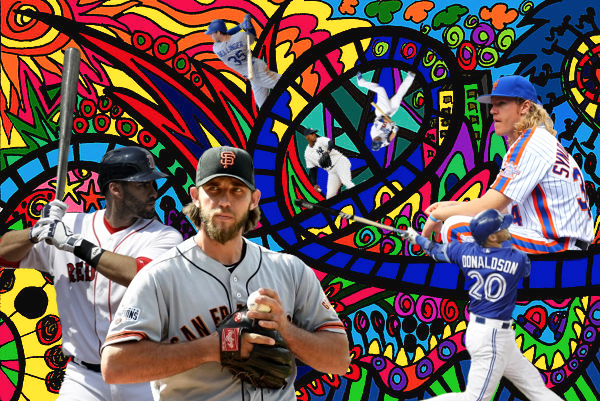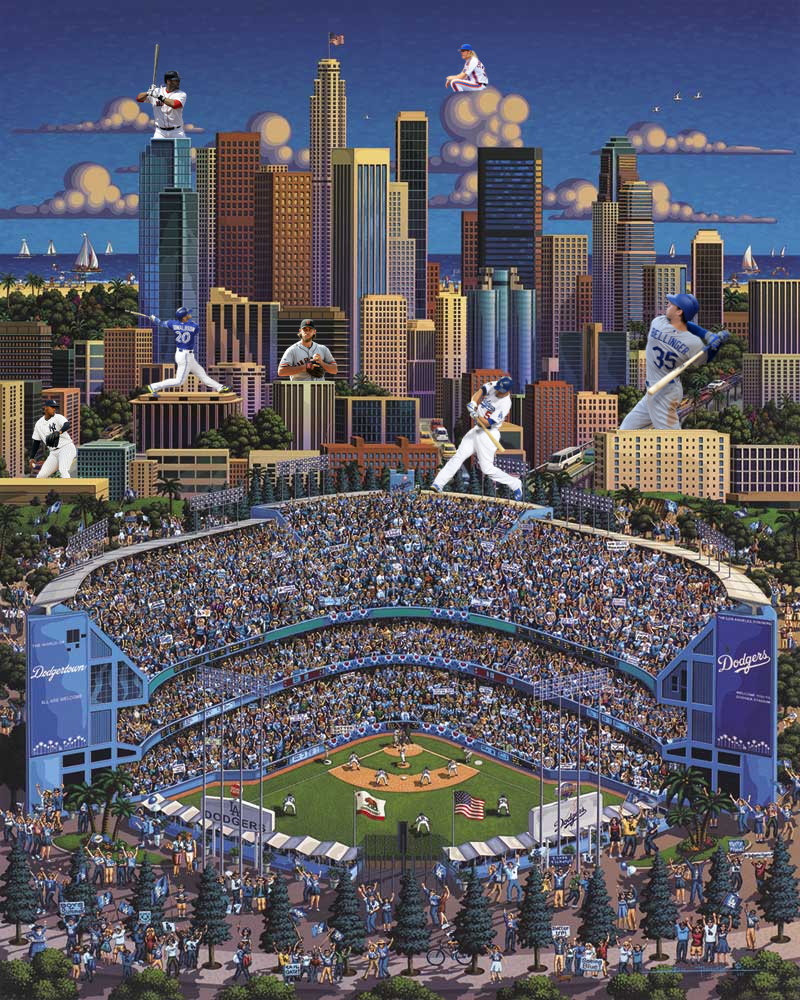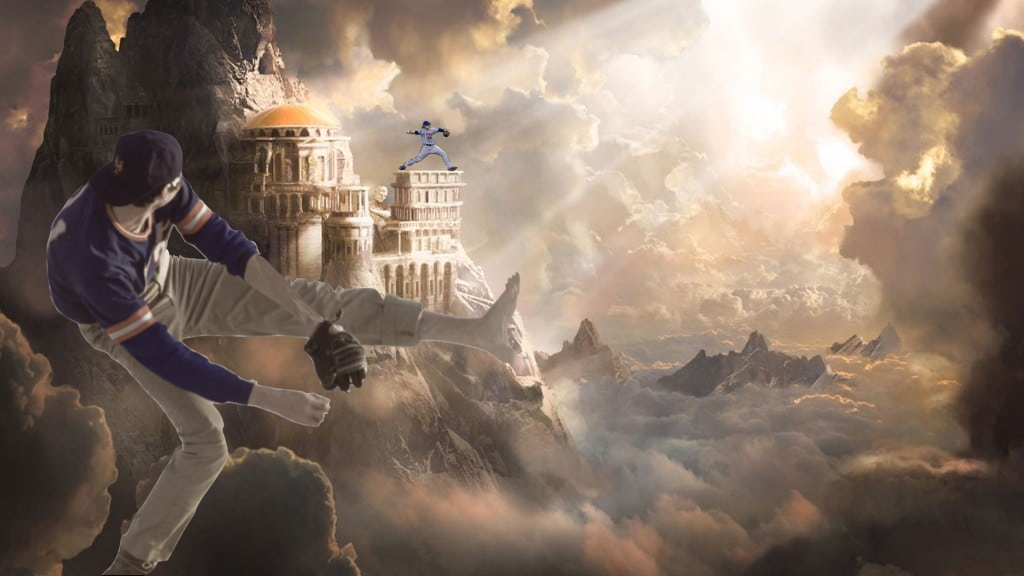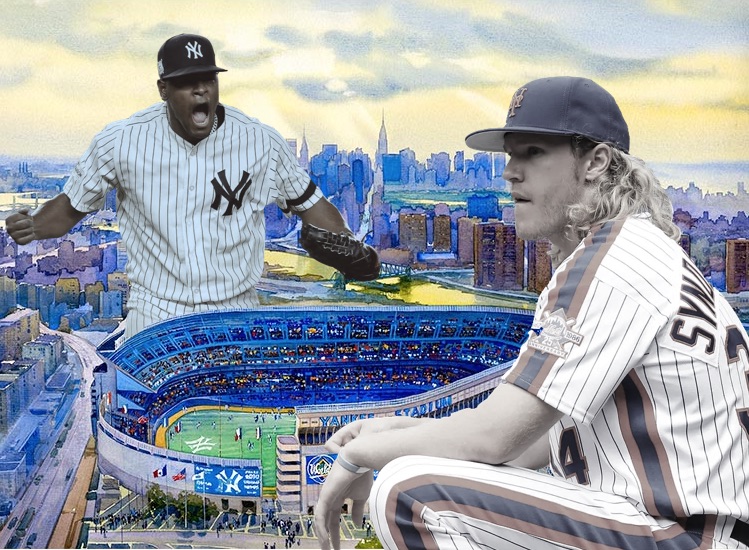Alas… we meet again!
In Part 2 we rescued Clayton Kershaw from the island, toured the Gallery de Votto, and hitched a ride with Mad Max. In Part 3 we will cover seven of the last elite talents before we cross the threshold known as the Mendozier Line. Christian Yelich and Carlos Martinez are nice players, but they are no Jose Ramirez or Chris Sale (now watch C-Mart and Yelich perform like 2nd rounders).
I also owe an apology to Corey Seager, his brother Kyle, and anyone associated with the good Seager name. I wrote that “the gap between the elite four shortstops (Trea, Correa, Manny, Lindor) and the rest is a wide ravine.” It isn’t. Corey Seager is a terrific player and all he needs to prove it is good health and some positive counting stat regression. Omitting Corey here was particularly egregious because these rankings are for OBP, where his .374 career mark stands out like a rose in winter. And next time, we’ll discuss how this time, I forgot to mention the shortstop-eligible Alex Bregman. Thames Time is a flat circle.

Fasten your seatbelts for the wild ride known as Part 3. We’ll ascend Mount Olympus and play catch with the son of Odin. We’ll take hacks with the Titan of Torque and chop lumber with Paul Bunyan’s only child. And we will stop to view a wild Severino in its natural habitat – but be on the lookout for 100mph projectiles!
You’ll be dizzy, euphoric, and hungry for more!
Some players will hit ceilings, some will fall through the floor
We can’t all sound pretty like Francisco Lindor…
And more will come… when we reach Part 4!
But first… a dazzling dandy with J.D.
Here come the seven who comprise Part 3:
Legend
![]() = Draft Target
= Draft Target
![]() = Performance Risk
= Performance Risk
![]() = Decline Risk
= Decline Risk
![]() = Health Risk
= Health Risk
![]() = Playing Time Risk
= Playing Time Risk
![]() = #1 Overall Player Upside
= #1 Overall Player Upside
![]() = 1st Round Upside
= 1st Round Upside
![]() = Top 30 Upside
= Top 30 Upside
![]() = Supremely High Floor
= Supremely High Floor
![]() = High Floor
= High Floor
![]() = 50 Home Run Potential
= 50 Home Run Potential
![]() = 30 Stolen Bases Potential
= 30 Stolen Bases Potential
![]() = Likely Imposed Innings Limit
= Likely Imposed Innings Limit
![]() = FIPster (FIP 1.00+ point lower than ERA in 2017)
= FIPster (FIP 1.00+ point lower than ERA in 2017)
![]() = The Plate Regression (BABIP below .275 in 2017)
= The Plate Regression (BABIP below .275 in 2017)
![]() = Post-Hype Sleeper
= Post-Hype Sleeper
![]() = Trending Up
= Trending Up
25. J.D. Martinez ![]()
![]()
![]()
![]()
Before we get into J.D.’s 2018 outlook I want you to see this. There are more stages in that swing than at Coachella. Now check out J.D. hitting this spring. My, how far we have come. Once upon a time, he was a kit of robot parts – and now he is a fully functioning robot. If the last few seasons are indicative of who he truly is, J.D. (short for Joe Dimaggio) is Nolan Arenado in the outfield. His Slugging Percentages the last four seasons are as follows: .553, .535, .535, .690. That is not a typo. A .690 Slugging Percentage in 2017. That’s almost as high as my rec league softball line! (We play here, and yes, you should be jealous).
If JDM is such a mighty force, why does he barely crack the top-25? I suppose it’s the total games played. In those a-four-mentioned seasons, he played a total of 520 games, an average of 130 per season. If we are quick to knock pitchers with limited track records of good health like Lance McCullers or discount a .900 OPS bat like Yoenis Cespedes, what makes J.D. Martinez so different? Oh, it must be that .690 slugging percentage. Touche’.
.297-91-36-109-4
As Jalen Rose would say, (sometimes) you gotta give the people what they want.
Now that we took care of that, we can discuss Bumgarner as a pitcher. Talk about a pitching prospect panning out. Holy moly. I vividly remember when Bumgarner was just a prospect. In all honesty, I can’t say I was any more impressed with him than, say, prospect Martin Perez. Bumgarner was this lanky, side-winding kid… and then bam, almost overnight he turned into a man.
What followed was nothing short of historic. Bumgarner put together the best playoff run for a pitcher in the history of baseball, and while he should be a Peyton Manning-like presence who frequents Pepsi commercials and broadcast booths everywhere, I’m just fine imagining him loading up his truck with firewood and living a good, wholesome life without all the buzz and distraction that typically comes with, ya know, performing in the playoffs and World Series like a folklore hero.
Like his rival Kershaw, his fastball isn’t a Severino-esque laser beam, but he checks all the other boxes emphatically. He is durable and consistent and tough and deceptive and just overpowering enough to be a menace on the mound. If there is one caution flag with Bumgarner it’s that he was hit significantly harder in 2017 than ever before, including a .340+ ISO in August and September (per Fangraphs). Still, I love targeting him as a 3rd round ace once the Big 4 come off the board. Bumgarner’s stock is mildly depressed due to missing time in 2017, but come May we will all be reminded “Few are those who are better.” Draft with confidence.
EDIT: During the process of making psychedelic rollercoaster photoshops editing this, Bumgarner fractured his hand. Bummer. We’ll keep him here at #26 to stay true to the original rankings, but when drafting, take into consideration that he is likely to miss the first 6-8 weeks of the season. In Rotisserie this bumps him down to the Chris Archer tier, possibly below. In H2H I don’t think the drop is quite as severe, because if you can keep your team afloat, you’ll still play most of the season – and the playoffs – with Madison Bumgarner. But in roto, the injury sets you up for an arduous uphill climb.
27. Corey Seager ![]()
![]()
![]()
If Corey Seager reaches his true ceiling, the result will be a Votto-like hitter at shortstop; a player whose magnificent on-base skills and pure hitting ability will never be quite properly captured by the limitations of fantasy baseball, but who offers a floor in the clouds and an annual top-20 ceiling. Seager is a prolific hitter and his counting stats are bound to eventually catch up with his skills. The obvious concern is his health and whispers of Tommy John surgery, but with good health, expect Anthony Rendon numbers (.300-25-90) at shortstop with the potential for a gargantuan .330-100-30-100-5 season. I understand the trepidation to draft Seager this season, but considering the notable drop-off at shortstop, and the notion that batting average/OBP is the most difficult statistic to grab off the wire, I am glad snag Seager in the middle of the third round, and it’s possible his injury concerns will encourage your league-mates to let him fall even further. Draft him as your starting shortstop and don’t look back.
.305-93-28-89-5

28. Cody Bellinger ![]()
![]()
![]()
![]()
Two young Dodgers hitters back-to-back in the top-30 and they have the best starting pitcher and the best relief pitcher. The .900 OPSing Justin Turner is like their George Harrison (at best). Rich Hill and his 11.0 K/9 is the security guard who keeps groupies away from Alex Wood. What a disgusting team they are.
Bellinger comes with strikeout concerns, but he is as good a bet as anyone to lead the National League in home runs this season – and if he can keep the batting average above .260 and the OBP in the .340+ range… we are looking at a top-30 fantasy player. If he swipes 12-15 bags too… fuh-gettt-it (as my Grandfather from Brooklyn used to say). My Grandfather was a Dodgers fan who spent childhood summers at Ebbets Field, then moved to Southern California and got to witness the entirety of prime Koufax. Let’s just say that growing up in an area teeming with rabid Giants fans was very confusing for me. One time as a kid at Candlestick Park I accidentally cheered after an Eric Karros double and a group of Giants fans kidnapped me and left me at Haight-Ashbury. A few weird smells later and here we are… anyway, Bellinger is a beast. There are no two ways around it. But I can’t lie that watching his ascension last year was incredibly painful – I had two Minor League keeper slots in a keeper league and prior to his call-up, Bellinger was inexplicably not rostered, but I refused to pick him up because it would require dropping Austin Meadows. Oops. Who ended up with Bellinger? My best pal Nate, our back-to-back champ and a die-hard Giants fan. Suddenly I don’t feel so good. Let’s talk about Josh Donaldson.
.272-92-41-98-13
29. Josh Donaldson ![]()
![]()
![]()
![]()
The Donaldson is a 1st-round caliber bat with 12th-place-and-too-bad–about-that-hamstring downside. Is it worth paying up for his 40-120 potential, when solid third basemen like Eugenio Suarez and Other Seager are waiting for you 10+ rounds later? Personally, I’m hoping someone else takes Donaldson at a seemingly “appropriate” time and relieves me of that tough decision.
Injury risk aside, he is a potent offensive player. If you watched the video earlier, it quickly becomes clear that Donaldson is a baseball obsessive, borderline OCD level. He is that kid who discovers dinosaurs and that is all he can ever think about (21). We like this from our fantasy players. We don’t want them bothering with all the other things in Maslow’s Hierarchy of Needs. Eat, s***, swing. It’s a recipe for 35+ bombs and success into your mid-thirties.
On draft day, anything past the second round feels like value. Offensively he is a bit like Kris Bryant but without youth on his side and far more health risk. Toronto’s lineup appears mediocre at best, but in a H2H matchup, there are few opponents more terrifying to face than Josh Donaldson. Bothered hamstrings and modest decline risk keep him out of the top-20, but Donaldson could easily play like a 1st rounder.
.279-84-38-94-2
(21) To any paleontologists reading, you have my utmost respect and admiration.
30. Noah Syndergaard ![]()
![]()
![]()
On April 1st, 1985, Sports Illustrated published a detailed article featuring a young Mets pitcher with unrivaled velocity and the potential for greatness matched by no one who has ever thrown a baseball. That April Fool’s joke – which genuinely duped thousands of people – has become a prophecy. Sidd Finch has arrived, and his name is Noah Syndergaard.
If there is a man alive who can become the next Roger Clemens, it’s Noah (sorry, Koby). His 93 mph slider is harder than most fastballs, and his fastball is nearly unhittable. He is an incredible source of strikeouts, low WHIP, and a minuscule ERA. If you combined Aroldis Chapman’s fastball, Kyle Hendricks‘ command, and Chris Archer’s strikeout rate, the result would be Noah Syndergaard. The only concern – and it’s a significant one – is Noah’s injury risk.
÷÷÷÷÷÷÷÷÷÷÷÷÷÷÷÷÷÷÷÷÷÷÷÷÷÷÷÷÷÷÷÷÷≠≠≠≠≠≠≠≠≠≠≠≠≠≠≠≠≠≠≠≠≠≠ºππ–π
My tiger-striped cat Miguel made those markings above. I think he was trying to say “avoid! avoid!”
How timely. Maybe cats are smarter than humans, but they keep it under wraps in order to be pampered, fed, groomed, and adored. And perhaps Miguel subscribes to the theory that velocity equates to injury risk, and therefore, Thor is as risky as they come. But the biggest risk of all, Miguel, is to not take any risks.
Syndergaard’s current ADP is 28th overall. In an ideal draft, I’d select hitters in the first 2-3 rounds, then snag Syndergaard as my ace in the late 3rd or early 4th. Pitch for pitch he is a top-5 pitcher in baseball (at the very least) with an arsenal of pitches so lively and overpowering it almost seems unfair. In terms of pure best-case-scenario upside, the only other starting pitcher in his stratosphere is Kershaw. Not Sale, not Scherzer, not even the flamethrowing Luis Severino, whom Thor makes appear hittable by comparison. In terms of raw, unfiltered stuff, he is in a league of his own.
Outlook: After pitching only 30.1 innings last season, Syndergaard is an upside pick for the bold. I understand if you prefer Greinke or deGrom due to perceived safety. I understand, I understand, I understand. Miguel understands. But for those who want to reach the top of Mount Olympus, Noah Syndergaard will take you there.

31. Luis Severino ![]()
![]()
The Baseball Gods shone their light on Luis Severino last season, as he completely fulfilled all the promise he showed as a young prospect (and then some). He finished 3rd in the AL Cy Young voting behind Kluber and Sale, and posted a 2.98 ERA and a gaudy 230 strikeouts in 193.1 innings. In 2018 he will operate as the flamethrowing ace for a comically stacked Yankees offense. A combination of wins, strikeouts, and elite peripherals should lead him to another top-15 season.
True story: last year I watched Severino’s second start of the year (versus Tampa Bay) where he hit triple digits and struck out 11 batters. I was geeked out of my mind but had already used my two weekly free agent acquisitions (we instated this rule to prevent excess pitcher steaming, where teams can win the QS and K’s categories due to quantity, rather than quality of performance). Desperate to add Severino, but out of moves, I hatched a plan: I would offer a future draft pick to a team with a remaining acquisition, if they would add Severino, then trade him to me for my worst player. In retrospect, I’m not sure if this is brilliant or dishonorable or both. What I do know, is that up to that point, Severino had left a bad taste in most fantasy manager’s mouths, and wasn’t on most teams radar. My league-mate Eddie, GM of The Never Ending Story (more like Never Ending Strikeouts hehe) was more than happy to acquire the future 22nd draft pick I offered. So I flipped a 22nd round draft pick for Luis Severino and the rest is history.
Except it wasn’t. Little did I know, I was about to make a fatal error – one that haunts me to this day. You see, I had also nabbed Ryan Zimmerman off waivers after his torrid start, and he was showing no signs of stopping. But between his age, injury history, and ridiculous BABIP, he was probably the best “sell high” candidate I had ever seen. And so, I let it be known that I was entertaining offers for Zimmerman. Not long after, an intriguing offer came in from Wade Boggs Challenge (managed by Jonathan). He offered Jake Arrieta + Aaron Altherr for Ryan Zimmerman + Luis Severino. Let me tell you, I’ve always been intrigued by Altherr, and even now I believe he has untapped upside. I also have fond memories of my lethal 2015 team which included Jake Arrieta and his all-time great season. Unfortunately, that team was formed a year before our league switched to a keeper system, and unfortunately, despite drafting my best team ever, I was unexpectedly bounced in round 1 of the playoffs by the aforementioned Never Ending Story. That year I drafted proven studs Miguel Cabrera and Chris Sale in the first two rounds, then drafted the following players right before their monster breakouts: Donaldson (round 3 – he won MVP), Arenado (round 6), Mookie (round 7), Arrieta (round 8), J.D. Martinez (round 11), and A.J. Pollock (round 14). I also stashed Carlos Correa about one month prior to his call-up, which proved quite fruitful. It was the best team I have ever constructed (despite no ring to show for it) and in the years since I’ve done everything in my power to reassemble as much of that squad as possible. It was my 2001 Seattle Mariners.
That long boastful anecdote is a long way of saying: I had a personal attachment to Jake Arrieta, and when the Arrieta/Altherr trade offer came along, it was almost impossible not to resist, as much as I was infatuated with Severino’s raw stuff and the possibility of a major breakthrough. I agonized about the trade for three days, weighing the pros and cons, before one morning, feeling bold and caffeinated, I said “it’s Jake Arrieta!” and clicked “accept”.
What followed was nothing but pain and agony. Not only did Zimmerman continue to mash for two months after the trade, Severino emerged as one of the best pitchers in baseball, stringing together dominant start after dominant start, and incapacitating hitters with his overwhelming velocity and improved slider and changeup. Oh, and Jake Arrieta sucked (for much of the year).
It got to the point where I had to console myself with positive self-talk like “It’s okay, it’s just fantasy. There are kids in Africa who are born and then starve, and that’s all they ever get to do.” I use similar self-talk when getting vaccinations: “This isn’t that bad. You could be one of those guys in Saving Private Ryan lying on the beach with his entrails hanging out, crying for his mother.” Jeez, that got dark fast. My apologies. It must have been that Edgar Allen Poe vibe from Part 1.
Fortunately, the ending of this story isn’t a full-blown tragedy. I flipped Arrieta straight up for Jose Berrios, then packaged Berrios (along with Zimmer, Dahl, and others) to a rebuilding team for A.J. Pollock and Ryan Braun, who were helpful in my championship run. I got a ring. Nothing can take that away. But it will always be unsettling when I look at Wade Boggs Challenge roster and see Luis Severino front-lining his rotation.
Looking back, there were no rules in place to suggest that the way I acquired Severino was dishonorable. None of the other ten managers perceived the deal to be exploitative or voiced any kind of skepticism. But the Baseball Gods sensed a tear in the fabric of fantasy. A sever if you will. They knew – as did I, on some level – that the Acquisition Angels are not to be tested. I deserved my fate. I deserved every inning of pain and suffering and trader’s remorse.
You reap what you Severino.

